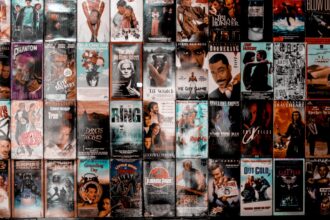The Central Intelligence Agency (CIA) has long been a subject of intrigue and speculation, particularly regarding its covert operations and the various methods it employs to achieve its objectives. Among these methods are CIA front organizations, which serve as a façade for the agency’s activities, allowing it to operate under the guise of legitimate entities. These organizations often engage in cultural, social, or political initiatives that align with U.S.
interests while maintaining a level of plausible deniability for the agency itself. The existence of such fronts raises questions about the ethical implications of using cultural initiatives as tools for political maneuvering. Front organizations have played a significant role in shaping public perception and influencing cultural narratives across the globe.
By funding and supporting various artistic and intellectual endeavors, the CIA has sought to promote values that resonate with American ideals, such as democracy and freedom of expression. However, the duality of these organizations—serving both as promoters of cultural freedom and as instruments of U.S.
Understanding the intricacies of CIA front organizations is essential for grasping their impact on global cultural dynamics and international relations.
Key Takeaways
- CIA front organizations have played a significant role in promoting cultural freedom and influencing global cultural movements.
- Historical examples, such as the Congress for Cultural Freedom, demonstrate the impact of CIA front organizations on shaping international cultural agendas.
- Critics argue that CIA front organizations are used to advance political agendas and manipulate media and arts.
- The evolution of CIA front organizations over time reflects changing global landscapes and international relations.
- The future of CIA front organizations remains uncertain in a rapidly changing global environment, raising questions about their legacy and impact.
The Role of CIA Front Organizations in Promoting Cultural Freedom
CIA front organizations have often positioned themselves as champions of cultural freedom, particularly during the Cold War era when ideological battles between the East and West were at their peak. By sponsoring artists, writers, and intellectuals who aligned with democratic values, these organizations aimed to counteract the influence of communist propaganda. The agency recognized that culture could be a powerful weapon in the ideological struggle, and thus, it invested in initiatives that showcased American art, literature, and music as embodiments of freedom and creativity.
Through various programs and initiatives, CIA front organizations facilitated cultural exchanges that allowed American artists to collaborate with their counterparts in other countries. This not only helped to promote American culture abroad but also fostered a sense of solidarity among those who shared similar values. By creating platforms for artistic expression, these organizations contributed to a broader narrative that celebrated individualism and freedom of thought, positioning themselves as defenders of cultural liberty in a world threatened by authoritarianism.
Historical Examples of CIA Front Organizations
One of the most notable examples of a CIA front organization is the Congress for Cultural Freedom (CCF), established in 1950. The CCF aimed to promote Western culture and ideas in Europe and beyond, particularly in countries susceptible to communist influence. Through various publications, conferences, and cultural events, the CCF sought to create a network of intellectuals who would advocate for democratic values and counteract the spread of communism.
The organization received substantial funding from the CIA, although this connection was kept secret for many years. Another significant example is the International Organizations Division (IOD), which operated under the CIA’s Office of Policy Coordination. The IOD was responsible for infiltrating various international organizations, including labor unions and cultural associations, to promote U.S.
interests. By supporting these groups financially and strategically, the CIA was able to influence their agendas and ensure that they aligned with American foreign policy objectives. These historical instances illustrate how front organizations were utilized as tools for ideological warfare during a time when cultural influence was seen as critical to national security.
The Impact of CIA Front Organizations on Global Cultural Movements
| Organization | Impact on Global Cultural Movements |
|---|---|
| The Congress for Cultural Freedom (CCF) | Supported anti-communist artists and intellectuals, shaping cultural narratives during the Cold War. |
| The Asia Foundation | Funded cultural projects to promote American values and counter communist influence in Asia. |
| The National Student Association (NSA) | Recruited students as informants and promoted American ideals on college campuses worldwide. |
The influence of CIA front organizations on global cultural movements cannot be overstated. By providing funding and support to artists and intellectuals, these organizations helped shape cultural landscapes in various countries. For instance, during the Cold War, many writers and artists from Eastern Europe received support from CIA-backed initiatives, allowing them to produce works that critiqued totalitarian regimes.
This not only bolstered their careers but also contributed to a broader discourse on freedom and human rights.
By facilitating collaborations between artists from different countries, CIA front organizations helped create a global dialogue around issues of freedom, democracy, and artistic expression.
This interconnectedness ultimately contributed to the emergence of cultural movements that challenged oppressive regimes and advocated for social change.
Criticisms and Controversies Surrounding CIA Front Organizations
Despite their contributions to promoting cultural freedom, CIA front organizations have faced significant criticism and controversy over the years. One major point of contention is the ethical implications of using culture as a tool for political manipulation. Critics argue that by funding artists and intellectuals, the CIA undermines the authenticity of their work, turning genuine expressions of creativity into propaganda vehicles for U.S.
interests. This raises questions about the integrity of artistic expression and whether it can truly be free when influenced by external forces. Additionally, the secrecy surrounding these organizations has fueled suspicions and conspiracy theories about their true intentions.
Many individuals have expressed concern that such covert operations compromise the independence of cultural institutions and artists alike. The revelation of CIA involvement in various cultural initiatives has led to calls for greater transparency and accountability in how governments engage with the arts. As a result, the legacy of CIA front organizations remains fraught with complexities that continue to spark debate among scholars, artists, and policymakers.
The Connection Between CIA Front Organizations and Political Agendas
The relationship between CIA front organizations and U.S. political agendas is deeply intertwined. These organizations were often established with specific geopolitical goals in mind, serving as instruments for advancing American interests abroad.
By promoting certain cultural narratives and ideologies, they aimed to create favorable conditions for U.S. foreign policy objectives. This strategic alignment underscores how culture can be weaponized in the service of political ends.
Moreover, the connection between these organizations and political agendas extends beyond mere funding; it involves shaping public opinion and influencing societal values in targeted regions. By carefully curating which artists or intellectuals received support, the CIA could effectively control the narrative surrounding key issues such as democracy, human rights, and capitalism. This manipulation of cultural discourse highlights the extent to which art and politics can intersect, raising important questions about the role of government in shaping cultural landscapes.
The Evolution of CIA Front Organizations Over Time
Over the decades, CIA front organizations have evolved in response to changing geopolitical landscapes and advancements in technology. Initially focused on combating communism during the Cold War, these organizations have adapted their strategies to address new challenges posed by globalization and digital communication. As information flows more freely across borders, the methods employed by these fronts have become more sophisticated, utilizing social media platforms and online networks to disseminate their messages.
In recent years, there has been a noticeable shift towards supporting grassroots movements and local artists rather than solely focusing on high-profile figures or established institutions. This evolution reflects an understanding that cultural influence is increasingly decentralized in today’s interconnected world. By engaging with local communities and fostering authentic connections, CIA front organizations aim to remain relevant while still promoting U.S.
interests abroad.
How CIA Front Organizations Influence Media and Arts
CIA front organizations have had a profound impact on media and arts by shaping narratives that align with American values. Through funding various media outlets, film productions, and artistic endeavors, these organizations have been able to influence public discourse on critical issues such as democracy, freedom of expression, and human rights. By promoting content that reflects U.S.
interests, they have effectively created a platform for disseminating specific ideological perspectives. Moreover, the influence extends beyond mere financial support; it involves strategic partnerships with influential figures in media and arts who can amplify these narratives. By collaborating with prominent artists or filmmakers who share similar values or ideologies, CIA front organizations can ensure that their messages reach wider audiences.
This symbiotic relationship between government-backed initiatives and creative industries raises important questions about artistic autonomy and the potential consequences of such collaborations on public perception.
The Relationship Between CIA Front Organizations and International Relations
The relationship between CIA front organizations and international relations is complex and multifaceted. These organizations often operate within broader diplomatic frameworks aimed at fostering alliances or countering adversarial influences. By promoting cultural initiatives that resonate with specific audiences abroad, they can help build goodwill towards the United States while simultaneously undermining rival ideologies.
Furthermore, this relationship is not limited to direct interactions with foreign governments; it also encompasses engagement with civil society actors such as NGOs, grassroots movements, and local artists. By supporting these entities through funding or resources, CIA front organizations can create networks that facilitate collaboration across borders while advancing U.S. interests indirectly.
This nuanced approach highlights how culture can serve as both a soft power tool for diplomacy and an instrument for achieving strategic objectives.
The Future of CIA Front Organizations in a Changing Global Landscape
As global dynamics continue to shift due to technological advancements and evolving geopolitical tensions, the future of CIA front organizations remains uncertain yet intriguing. The rise of digital communication has transformed how information is disseminated; thus, traditional methods employed by these fronts may need to adapt accordingly. Engaging with younger generations who are increasingly skeptical of government involvement in culture will require innovative strategies that prioritize authenticity over mere propaganda.
Moreover, as new challenges emerge—such as climate change or rising authoritarianism—CIA front organizations may find themselves recalibrating their focus areas to address pressing global issues while still promoting U.S. interests abroad. This adaptability will be crucial for maintaining relevance in an ever-changing landscape where cultural influence plays an increasingly vital role in shaping international relations.
The Legacy and Legacy of CIA Front Organizations
The legacy of CIA front organizations is one marked by both significant contributions to cultural freedom and profound ethical dilemmas surrounding their operations. While they have played a crucial role in promoting democratic values through art and intellectual discourse, their covert nature raises important questions about authenticity and integrity within creative fields. As society grapples with these complexities today—amidst ongoing debates about government involvement in culture—the lessons learned from past experiences remain relevant.
Ultimately, understanding the multifaceted nature of CIA front organizations provides valuable insights into how culture intersects with politics on a global scale. Their evolution over time reflects broader shifts within international relations while highlighting the enduring power dynamics at play within artistic expression itself. As we move forward into an increasingly interconnected world shaped by rapid change—both culturally and politically—the legacy left behind by these organizations will continue to resonate long into the future.
The intricate web of CIA front organizations has long been a subject of intrigue and debate, particularly concerning their influence on cultural freedom during the Cold War era. These organizations often operated under the guise of promoting artistic and intellectual endeavors, while subtly steering cultural narratives to align with U.S. interests. An insightful article that delves into this complex history can be found on the War Room website. It explores the nuanced strategies employed by these fronts and their lasting impact on global cultural landscapes. For a deeper understanding, you can read more about it here.
CHECK THIS OUT! 📽️🎞️ Hollywood’s Secret War: How the CIA Rewrote Movies
FAQs
What are CIA front organizations?
CIA front organizations are entities that are created or funded by the Central Intelligence Agency (CIA) for the purpose of carrying out covert operations, gathering intelligence, or influencing political and cultural developments in foreign countries.
What is cultural freedom?
Cultural freedom refers to the ability of individuals and communities to express, preserve, and develop their cultural identities without interference or repression from government or other external forces.
What is the role of CIA front organizations in cultural freedom?
CIA front organizations have been known to support and promote cultural activities, such as art exhibitions, music festivals, and literary events, in order to advance the interests of the United States and its allies, as well as to counter the influence of rival ideologies.
How have CIA front organizations been involved in cultural freedom?
CIA front organizations have been involved in cultural freedom by funding and supporting cultural initiatives, sponsoring artists and intellectuals, and promoting cultural exchange programs, often with the aim of advancing American interests and countering the influence of rival ideologies during the Cold War and beyond.
What are some examples of CIA front organizations involved in cultural freedom?
Some examples of CIA front organizations involved in cultural freedom include the Congress for Cultural Freedom, the National Student Association, and various foundations and cultural institutions that received covert funding from the CIA to promote American cultural values and influence cultural developments in foreign countries.




